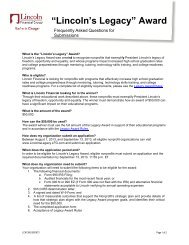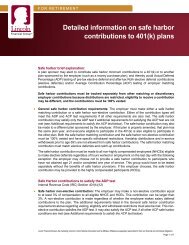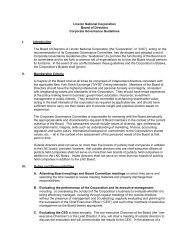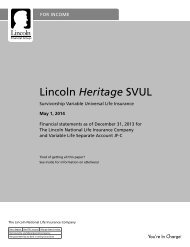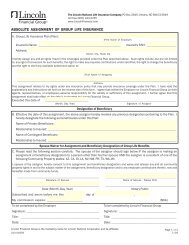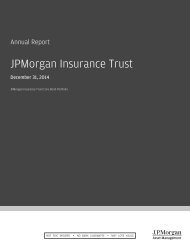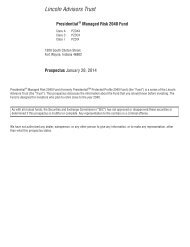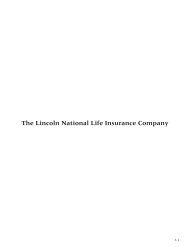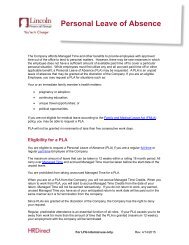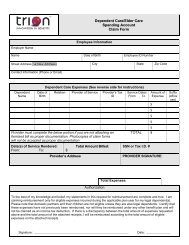2008 Annual Report to Shareholders - Lincoln Financial Group
2008 Annual Report to Shareholders - Lincoln Financial Group
2008 Annual Report to Shareholders - Lincoln Financial Group
You also want an ePaper? Increase the reach of your titles
YUMPU automatically turns print PDFs into web optimized ePapers that Google loves.
Item 1A. Risk Fac<strong>to</strong>rs<br />
You should carefully consider the risks described below before investing in our securities. The risks and uncertainties described<br />
below are not the only ones facing our company. Additional risks and uncertainties not presently known <strong>to</strong> us or that we currently<br />
deem immaterial may also impair our business operations. If any of these risks actually occur, our business, financial condition and<br />
results of operations could be materially affected. In that case, the value of our securities could decline substantially.<br />
Adverse capital and credit market conditions may significantly affect our ability <strong>to</strong> meet liquidity needs, access <strong>to</strong> capital<br />
and cost of capital.<br />
The capital and credit markets have been experiencing extreme volatility and disruption for more than twelve months. In some<br />
cases, the markets have exerted downward pressure on availability of liquidity and credit capacity for certain issuers.<br />
We maintain an investment portfolio of various holdings, types and maturities. These investments are subject <strong>to</strong> general credit,<br />
liquidity, market and interest rate risks. An extended disruption in the credit and capital markets could adversely affect LNC and<br />
its subsidiaries’ ability <strong>to</strong> access sources of liquidity, and there can be no assurance that additional financing will be available <strong>to</strong> us<br />
on favorable terms, or at all, in the current market environment. In addition, further other-than-temporary impairments could<br />
reduce our statu<strong>to</strong>ry surplus, leading <strong>to</strong> lower RBC ratios and potentially reducing future dividend capacity from our insurance<br />
subsidiaries.<br />
We need liquidity <strong>to</strong> pay our operating expenses, interest on our debt and dividends on our capital s<strong>to</strong>ck, <strong>to</strong> maintain our securities<br />
lending activities and <strong>to</strong> replace certain maturing liabilities. Without sufficient liquidity, we will be forced <strong>to</strong> curtail our operations,<br />
and our business will suffer. As a holding company with no direct operations, our principal asset is the capital s<strong>to</strong>ck of our<br />
insurance and investment management subsidiaries. Our ability <strong>to</strong> meet our obligations for payment of interest and principal on<br />
outstanding debt obligations, including the $500 million of senior securities due in April 2009, and <strong>to</strong> pay dividends <strong>to</strong> shareholders<br />
and corporate expenses depends significantly upon the surplus and earnings of our subsidiaries and the ability of our subsidiaries <strong>to</strong><br />
pay dividends or <strong>to</strong> advance or repay funds <strong>to</strong> us. Payments of dividends and advances or repayment of funds <strong>to</strong> us by our<br />
insurance subsidiaries are restricted by the applicable laws and regulations of their respective jurisdictions, including laws<br />
establishing minimum solvency and liquidity thresholds. Changes in these laws can constrain the ability of our subsidiaries <strong>to</strong> pay<br />
dividends or <strong>to</strong> advance or repay funds <strong>to</strong> us in sufficient amounts and at times necessary <strong>to</strong> meet our debt obligations and<br />
corporate expenses. For our insurance and other subsidiaries, the principal sources of our liquidity are insurance premiums and<br />
fees, annuity considerations, investment advisory fees, and cash flow from our investment portfolio and assets, consisting mainly of<br />
cash or assets that are readily convertible in<strong>to</strong> cash. At the holding company level, sources of liquidity in normal markets also<br />
include a variety of short- and long-term instruments, including credit facilities, commercial paper and medium- and long-term<br />
debt.<br />
In the event that current resources do not satisfy our needs, we may have <strong>to</strong> seek additional financing. The availability of<br />
additional financing will depend on a variety of fac<strong>to</strong>rs such as market conditions, the general availability of credit, the volume of<br />
trading activities, the overall availability of credit <strong>to</strong> the financial services industry, our credit ratings and credit capacity, as well as<br />
the possibility that cus<strong>to</strong>mers or lenders could develop a negative perception of our long- or short-term financial prospects if we<br />
incur large investment losses or if the level of our business activity decreases due <strong>to</strong> a market downturn. Similarly, our access <strong>to</strong><br />
funds may be impaired if regula<strong>to</strong>ry authorities or rating agencies take negative actions against us as has happened recently. See<br />
“Item 1. Business – Ratings” for a complete description of our ratings and ratings outlook. Our internal sources of liquidity may<br />
prove <strong>to</strong> be insufficient, and in such case, we may not be able <strong>to</strong> successfully obtain additional financing on favorable terms, or at<br />
all.<br />
Disruptions, uncertainty or volatility in the capital and credit markets may also limit our access <strong>to</strong> capital required <strong>to</strong> operate our<br />
business, most significantly our insurance operations. Such market conditions may limit our ability <strong>to</strong> replace, in a timely manner,<br />
maturing liabilities; satisfy statu<strong>to</strong>ry capital requirements; generate fee income and market-related revenue <strong>to</strong> meet liquidity needs;<br />
and access the capital necessary <strong>to</strong> grow our business. As such, we may be forced <strong>to</strong> delay raising capital, issue shorter term<br />
securities than we prefer, or bear an unattractive cost of capital which could decrease our profitability and significantly reduce our<br />
financial flexibility. Recently, our credit spreads have widened considerably, which increases the interest rate we must pay on any<br />
new debt obligation we may issue. Our results of operations, financial condition, cash flows and statu<strong>to</strong>ry capital position could be<br />
materially adversely affected by disruptions in the financial markets.<br />
28



